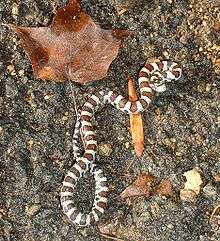Eastern milk snake
| Eastern milk snake | |
|---|---|
 | |
| Adult eastern milk snake in Tennessee | |
| Scientific classification | |
| Kingdom: | Animalia |
| Phylum: | Chordata |
| Class: | Reptilia |
| Order: | Squamata |
| Suborder: | Serpentes |
| Family: | Colubridae |
| Genus: | Lampropeltis |
| Species: | L. triangulum |
| Subspecies: | L. t. triangulum |
| Trinomial name | |
| Lampropeltis triangulum triangulum (LaCépède, 1789) | |

.jpg)

Lampropeltis triangulum triangulum, commonly known as the eastern milk snake or eastern milksnake, is a subspecies of Lampropeltis triangulum.[1] The nonvenomous, colubrid snake is indigenous to eastern and central North America.[2]
Geographic range
The eastern milk snake ranges from Maine to Ontario in the north to Alabama and North Carolina in the south.[2] It was once thought by herpetologists to intergrade with Lampropeltis elapsoides, the scarlet kingsnake, in a portion of its southern range, but this has been disproved.[3][4]
Description
Eastern milk snakes average 60 to 91 centimetres (24 to 36 in) in length, although specimens as long as 132 centimetres (52 in) have been measured. They have smooth and shiny scales. Their dorsal color pattern is narrow bands of white and black, alternated with brownish dorsal saddles. The dorsal saddles are sometimes reddish or reddish brown in the southern areas of their range.[2][5] The pattern on the top and sides of the snake has also been described as three (or possibly five) series of black-bordered brown (reddish brown sometimes) blotches along the length of the snake on a gray or tan ground. The blotches in the dorsal series are large, while the blotches in the two (or possibly four) lateral series are smaller. The belly pattern is black and white checks (often irregular).[6]
Captivity
Like many species of milk snakes, the Eastern milk snake is often bred in captivity for the pet trade. It is generally docile and rarely attempts to bite, though may attempt to do so if feeling restrained. Milk snakes of most varieties like this species tend to acclimate well to 10-15 gallon terrariums, though a larger enclosure is generally needed for larger species. As with most captive snakes, they tend to thrive on a diet of pre-killed rodents, with the occasional picky neonate requiring a pinky mouse scented with the smell of a lizard.[7]
References
- ↑ Savitzky, Alan H. (2004). Hutchins, Michael; et al., eds. Grzimek's Animal Life Encyclopedia. 7: Reptiles. Detroit: Gale. p. 477.
- 1 2 3 Mount, Robert H. (1975). The Reptiles and Amphibians of Alabama. Auburn, Alabama: Auburn Printing Company. pp. 200–201. OCLC 1958638.
- ↑ Williams, Kenneth L. (1988). Systematics and natural history of the American milk snake, Lampropeltis triangulum. Milwaukee, Wisconsin: Milwaukee Public Museum.
- ↑ Armstrong, Michael P.; Frymire, David; Zimmerer, Edmund J. (December 2001). "Analysis of sympatric populations of Lampropeltis triangulum syspila and Lampropeltis triangulum elapsoides, in western Kentucky and adjacent Tennessee with relation to the taxonomic status of the scarlet kingsnake". Journal of Herpetology. 35 (4): 688–93. JSTOR 1565915. doi:10.2307/1565915.
- ↑ Behler, John L.; King, F. Wayne (1979). The Audubon Society field guide to North American reptiles and amphibians. New York: Knopf. p. 457. ISBN 9780394508245.
- ↑ Conant, Roger; Collins, Joseph T. (1991). Reptiles and Amphibians. Peterson Field Guides. Boston: Houghton Mifflin. p. 207. ISBN 9780395583890.
- ↑ http://www.vmsherp.com/CarePages/CareMilks.htm
External links
| Wikimedia Commons has media related to Lampropeltis triangulum. |